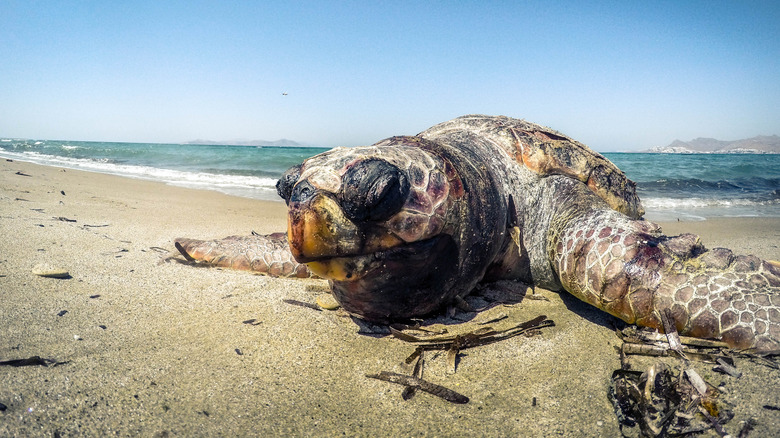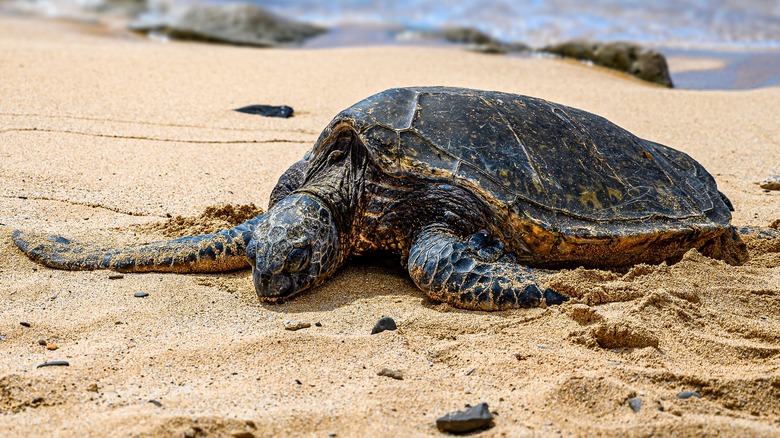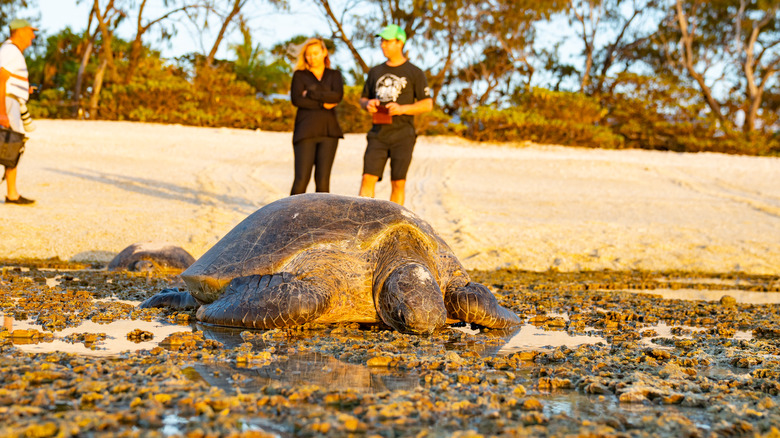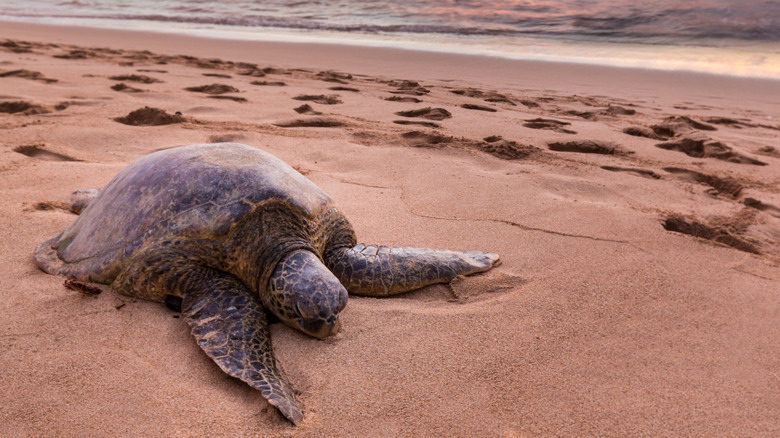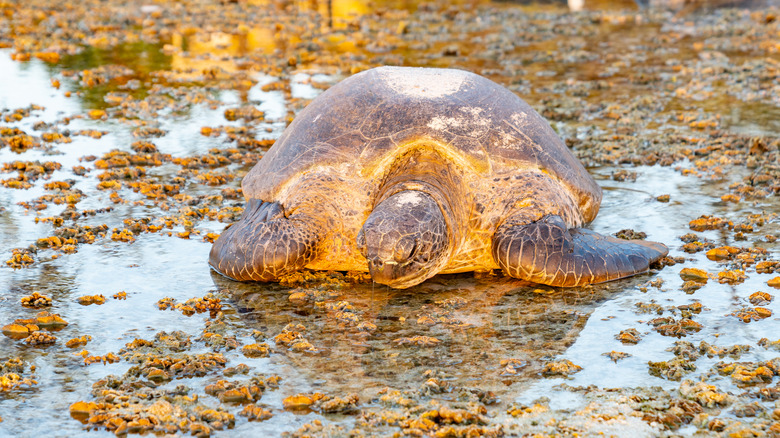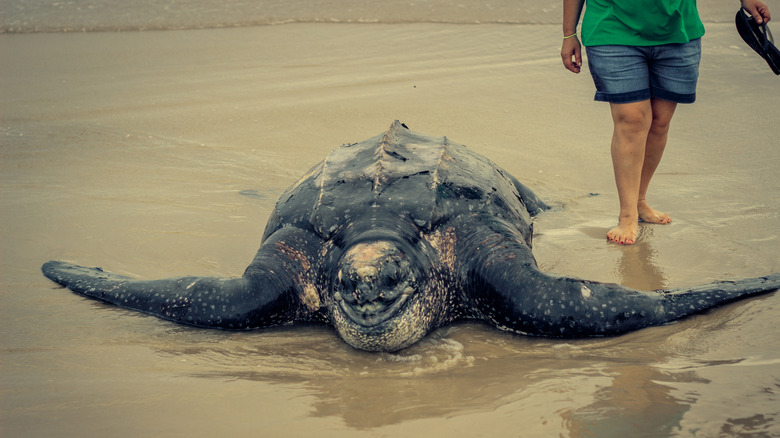If You Find A Stranded Sea Turtle At The Beach, Take These Steps Immediately
Picture this: You're jogging on the beach at sunrise, and you spot a large object on the sand a few hundred feet ahead of you. As you get closer, you realize it's a 300-pound sea turtle. After snapping some shots and sending them to your "pics or it didn't happen" friend, you know you need to do something, but what? Unless you have experience in this department or are otherwise familiar with sea-life rescue, you'll be left scratching your head.
Turtle strandings are common and can occur for various reasons, including cold stunning, injury or illness, starvation, unusual weather, and fishing gear entanglement. Unfortunately, sea turtles can also wash up on shore after dying in the water, or they can die on the shore after being stranded for a long period of time. If you find a turtle that's still alive, your actions can make the difference in its chances of recovery and release, so it's best to be smart and act wisely. Reading these steps will help you be more prepared. From calling the right people for help to leaving the turtle undisturbed, everything you do should prioritize the turtle's safety. It's also worth mentioning that similar steps apply if you spot an endangered whale or other sea animal.
Call your local marine life stranding network for help with the sea turtle
Thousands of sea animals become stranded on a beach somewhere in the world every year, and thousands of professionals are available in coastal areas across the globe to help them. While you may feel compelled to physically do something as soon as you see the turtle, the first thing you should do is call a stranding network for help. The sooner you call for assistance, the sooner the turtle can recover and be released back into the water by a team of trained professionals.
You can find the number of your local stranding network by visiting the National Oceanic and Atmospheric Administration (NOAA) Fisheries website and selecting your region, assuming you spotted the turtle in the United States. You can also do an online search for "sea turtle rescue + your location" for a list of places nearby that you can call. Be prepared to answer any questions the responder might have, including your exact location on the beach and the turtle's description.
Give the sea turtle space, and stay quiet
It's natural to want to be helpful if you find an animal in need, so the last thing you want to do is inadvertently harm the sea turtle in a careless attempt to rescue it. Unless you're a trained professional, it's best to keep your distance from the reptile. NOAA Fisheries recommends staying at least 150 feet away. A beached sea animal might behave defensively and bite you. It won't know that you're trying to help it and could become distressed as it sees you approaching. In fact, California's dolphins and sea lions have been attacking humans increasingly in 2025, so be extra careful.
While keeping your distance, you should also stay quiet and calm. Don't shout or make other loud noises, as these sounds may upset the turtle. This is especially important to remember if the turtle is nesting; after all, not every turtle on shore is stranded. Female turtles intentionally swim ashore to nest, but a frightened nesting turtle might scurry back into the water before she's laid her eggs. There are even events called false crawls, which is when a sea turtle comes onto land but doesn't lay eggs — not from being scared away but for other reasons, like the beach being too rocky.
Leave the sea turtle where it is
You may have seen videos on the internet of people with seemingly good intentions pushing a beached sea turtle back into the water. While some of these videos appear to have a happy ending that include the turtle swimming away, the true ending after the filming stops isn't always known. Not every turtle survives after being moved back into the water, and unfortunately, some animal rescue videos are staged, with people intentionally endangering an animal off-camera so they can "rescue" it while being filmed.
Despite what you've seen online, don't attempt to move the sea turtle yourself or with a friend. Don't try to push it back into the water with the assumption that being submerged in saltwater is the only thing it needs at that moment. Remember, some turtles wash up on shore because they're injured or sick. These turtles require professional medical care or rehabilitation before being released back into the water. That means if you return a turtle to the water in this condition, you could actually jeopardize its well-being.
Minimize other disturbances to the sea turtle, if possible
While you may be doing the right thing by not moving or touching the turtle or making loud noises, it's important for everyone around you to do the same. Other animals, such as barking dogs, and bystanders can inadvertently create disturbances, too, which can cause distress for the turtle. If there's anyone nearby, or if you notice people or dogs approaching, encourage them to also keep their distance and stay quiet for the turtle's sake. Let them know about the possible dangers that they can cause.
Of course, you only have control over your own actions, so while you might discourage others from bothering the turtle, there's no guarantee they'll listen. After all, some people would rather prioritize their desire to be a hero over an animal's safety with hopes of gaining their 15 minutes of fame. If necessary, you can call NOAA's National Enforcement Hotline at 800-583-1964 to report incidents of people disturbing the turtle.
If you can, stay with the sea turtle until help arrives
The wait time before a rescue team arrives to help the turtle depends on a number of factors, including the time of day and how far away the rescue center is. Since there's a possibility that the turtle will end up waiting longer than five or 10 minutes, stay with it if you can, until the professionals find you.
If you're on the scene when help arrives, it will give the rescuers the opportunity to learn of any status changes from you since you first made the call. They may also ask additional questions that they didn't ask when you called. Plus, your staying with the turtle will hopefully increase the odds that the turtle will be safe from any ill-willed people or animals. And of course, you'll probably want to witness the rescue process anyway, so it's a win-win if you stay. Interested in learning more about other reptiles similar to sea turtles? Check out the largest tortoise ever recorded in captivity.
